

EXTREME IDIOTS COMPILATION [Stupid People] Bite Cam & Necropsy. Elvis: Rampage Edition. 5.3. Choosing an experimental design. Full Factorial Designs. Experimental and quasi-experimental research designs. Experiments: Types. Types of experiments By definition, all experiments involve manipulation of one or more independent variables, and observing the effect on some outcome (dependent variable).
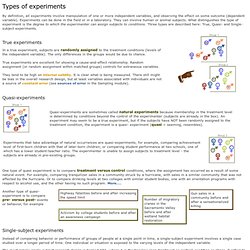
Experiments can be done in the field or in a laboratory. They can involve human or animal subjects. What distinguishes the type of experiment is the degree to which the experimenter can assign subjects to conditions. Basic Experimental Design. Sid Sytsma Website Administrator's Note: I have always considered Sid Sytsma's short article on experimental design one of the best short pieces on the subject I have ever seen, and provided a link to it from my Lutherie Information Website.
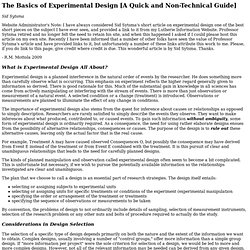
Professor Sytsma retired and no longer felt the need to retain his site, and when this happened I asked if I could please host this article on my own site. Recently I have been informed that a number of other folks have seen the value of Professor Sytsma's article and have provided links to it, but unfortunately a number of these links attribute this work to me. Please, if you do link to this page, give credit where credit is due. Supplementary Reading on Types of Experiment. [Return to X200 Home Page] From Carey, A Beginner's Guide to Scientific Method So far in our discussion of causal experiments, we have considered only examples designed by selecting a number of subjects (none of whom have the suspected causal agent), dividing them into two groups, and administering the suspected causal agent to members of one of the two groups.
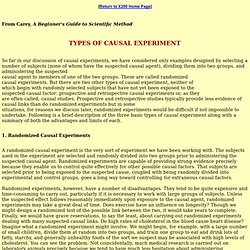
These are called randomized causal experiments. But there are two other types of causal experiment, neither of which begin with randomly selected subjects that have not yet been exposed to the suspected causal factor: prospective and retrospective causal experiments or, as they are often called, causal studies. Prospective and retrospective studies typically provide less evidence of causal links than do randomized experiments but in some situations, for reasons we discuss later, randomized experiments would be difficult if not impossible to undertake. CONCEPTS OF EXPERIMENTAL DESIGN_081005.doc - sixsigma1.pdf. Types of Experimental Designs. Experimental Designs The "One-Shot Case Study" No control group.
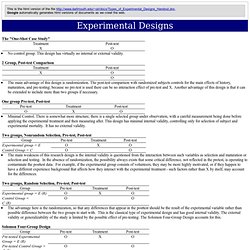
This design has virtually no internal or external validity. 2 Group, Post-test Comparison. Within-subjects vs. Between-subjects Designs: Which to Use? I.
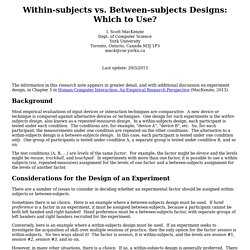
Scott MacKenzie Dept. of Computer Science York University Toronto, Ontario, Canada M3J 1P3 mack@cse.yorku.ca Last update: 10/11/2013 The information in this research note appears in greater detail, and with additional discussion on experiment design, in Chapter 5 in Human-Computer Interaction: An Empirical Research Perspective (MacKenzie, 2013). National News. - NEL. Research Design and Implementation (RDI) Checklists Each study the DGAC reviewed received a quality rating of positive, neutral, or negative, based upon a predefined scoring system.
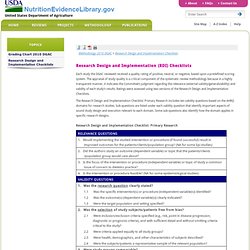
The appraisal of study quality is a critical component of the systematic review methodology because in a highly transparent manner, it indicates the Committee’s judgment regarding the relevance (external validity/generalizability) and validity of each study’s results. Art_ck_freed.pdf. Meese_methods.pdf. PSY2174_S11_Slides08Multifactorial.key - PSY2174_S11_Slides08Multifactorial.pdf. 32400_fm.indd - 9781111532406_lores_p01_ch03.pdf. Journal of Mixed Methods Research. Quasi-experimental Research. The prefix “quasi” means, in essence, “sort of.”
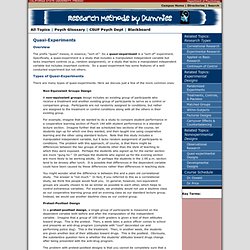
Designing a Survey. Please ensure you have JavaScript enabled in your browser. If you leave JavaScript disabled, you will only access a portion of the content we are providing. <a href="/science-fair-projects/javascript_help.php">Here's how. </a> The key to obtaining good data through a survey is to develop a good survey questionnaire. Whether you are conducting interviews or mailing out surveys, you will need to know how to design a good survey questionnaire. What is a survey questionnaire? Survey questionnaires present a set of questions to a subject who with his/her responses will provide data to a researcher. Objectives The key to developing a good survey questionnaire is to keep it short while ensuring that you capture all of the information that you need.
Now that you know what you are looking for, you can begin to structure the questions that will help you capture the information. Smart Survey Design - SmartSurvey.pdf. Design Tips: How to create and administer effective surveys. An important goal as a survey author is to construct clear, direct questions using the language that survey participants will understand.

While there are no set rules on the wording of these questions, there are some basic principles that do work to improve the overall design. Most importantly, make sure your survey is relevant, accurate, and valid. Be familiar with the questions + Know the objectives + Know the kinds of information needed = RELEVANCY This article provides tips on utilizing specific principles to construct effective surveys: Creating Great Questions Available SurveyMonkey Question Types Use of Space and Design Improve Response Rates For more information, please download the Best Practices Survey Guide (*Available in English Only). Types of Research Designs - WmMTrochim.pdf. University of Minnesota. In order to find the best possible evidence, it helps to understand the basic designs of research studies.

The following basic definitions and examples of clinical research designs follow the “levels of evidence.” Case Series and Case Reports: Types and designs - Psychteacher. Experiments in psychology research Types of experimentsLaboratory experimentsThese are highly controlled experiments carried out in an artificial setting.

Any location can be a laboratory, but it must be one in which extraneous variables such as noise, temperature, light, seating arrangements, etc can be kept constant for all participants. Any tasks participants take part in tend to be artificial and unrepresentative of everyday life (e.g. watching film clips as opposed to real events, memorising lists of random words, etc). The important factor is that the researcher has complete control over the independent variable.Field experimentsA field experiment is carried out in a more naturalistic setting than a laboratory experiment. This means that the tasks carried out by participants are more representative of everyday life, but there is still some degree of artificiality because the researcher still has complete control of the independent variable.